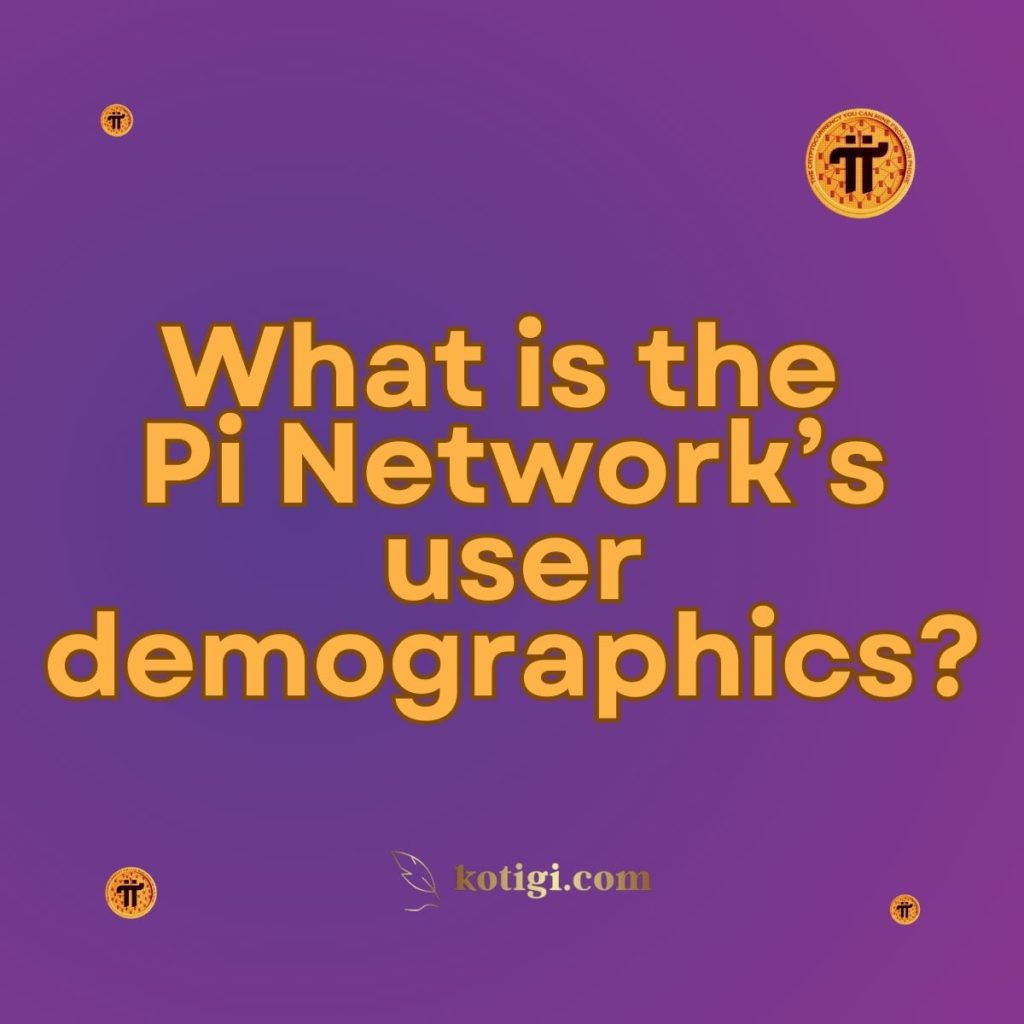
What is the Pi Network’s users demographics?
Pi Network’s user demographics are global and diverse, with a significant presence in regions such as Asia, Africa, and South America. The platform attracts users from various age groups, primarily tech-savvy individuals and early cryptocurrency adopters. Its global outreach, accessibility, and mobile-first mining approach appeal to users who are new to cryptocurrency and those interested in innovative blockchain solutions.
Introduction
Pi Network’s user demographics highlight the platform’s global appeal and diversity. Since its inception, Pi has attracted millions of users from different regions, age groups, and backgrounds. Understanding these demographics is crucial in analyzing the platform’s reach and growth potential, as it plays a significant role in its user acquisition and retention strategies. This post will explore the key demographic insights of Pi Network, including regional distribution, age groups, user interests, and socioeconomic factors that drive participation.
1. Global User Base
Pi Network boasts a global user base that spans multiple continents and countries. Its accessibility via mobile phones and low entry barriers make it popular worldwide.
1.1 Strong Presence in Asia
Asia represents a large portion of Pi Network’s users, with countries like China, India, and Vietnam leading the way. The region’s increasing interest in cryptocurrency and blockchain technology makes it fertile ground for Pi Network’s growth.
1.2 Emerging Markets in Africa
Pi Network has also gained considerable traction in Africa. The continent’s growing mobile phone penetration and need for alternative financial solutions make it an ideal market for Pi Network’s expansion. Countries like Nigeria and Ghana are showing significant interest.
1.3 Expanding Reach in South America
South America, particularly countries like Brazil and Argentina, has embraced Pi Network. Economic instability and interest in alternative currencies have driven many to explore cryptocurrency, with Pi offering a free and accessible entry point.
2. Age Demographics
Pi Network attracts a wide age range of users, though younger, tech-savvy individuals tend to dominate the platform.
2.1 Millennial and Gen Z Users
Millennials and Generation Z make up the majority of Pi Network’s user base. These groups are more open to adopting new technologies and are drawn to Pi Network’s innovative approach to cryptocurrency mining.
2.2 Older Users
While the majority of users are younger, Pi Network also has a growing base of older users who are interested in learning about cryptocurrency. Many older users join through family or community referrals, attracted by the simplicity of Pi’s mobile mining process.
3. Socioeconomic Diversity
Pi Network appeals to users from various socioeconomic backgrounds, as its mobile mining process is both free and requires minimal resources.
3.1 Users in Developing Economies
In regions with less access to traditional banking services, Pi Network is viewed as a gateway to financial inclusion. Users in developing economies appreciate the platform’s free and accessible nature, allowing them to participate in the cryptocurrency space without significant financial investment.
3.2 Tech Enthusiasts
Many Pi Network users come from a tech-savvy background, drawn to the blockchain and cryptocurrency space. These users are typically more familiar with the potential of digital currencies and are eager to be early adopters of innovative platforms like Pi.
3.3 Students and Young Professionals
Pi Network also has a large number of users who are students or young professionals. These individuals are often interested in the potential future value of Pi and see it as an opportunity to get involved in cryptocurrency without financial risk.
4. Gender Distribution
Pi Network’s gender distribution is skewed toward male users, though the platform is actively working to engage a broader demographic.
4.1 Male Dominance in User Base
As with many technology-driven platforms, Pi Network has a predominantly male user base. This trend is typical in cryptocurrency, where men tend to adopt new financial technologies earlier than women.
4.2 Growing Female Participation
However, Pi Network has seen a gradual increase in female users, especially in regions where mobile technology is widely used. Pi’s low barriers to entry and focus on mobile mining are appealing to women, particularly those interested in the future of digital finance.
4.3 Community Efforts to Balance Gender Representation
Pi Network has various initiatives within its community to encourage more female participation. Through community-driven programs and social media outreach, the platform is trying to create a more balanced gender demographic.
5. Education and Knowledge Levels
Pi Network users vary in their education levels, though many are self-learners and cryptocurrency enthusiasts.
5.1 Tech-Savvy and Crypto-Literate Users
A large portion of Pi’s user base consists of individuals who are well-versed in technology and cryptocurrency. These users are more likely to engage deeply with the platform, exploring its potential beyond simple mining.
5.2 General Users with Limited Knowledge
Pi Network also attracts users who are relatively new to cryptocurrency. These individuals are often drawn to Pi because of its simplicity and mobile-first approach, even if they have little prior knowledge of blockchain technology.
5.3 Educational Resources for Users
To cater to a wide range of users, Pi Network provides educational resources about blockchain, cryptocurrency, and the Pi ecosystem. This helps bridge the knowledge gap and engage a more diverse user base.
6. Regional Interests and Trends
Pi Network’s user engagement often correlates with regional interests in blockchain technology, fintech, and decentralized finance (DeFi).
6.1 Regions with High Blockchain Adoption
Countries with higher rates of blockchain adoption tend to have more active Pi users. Regions like Southeast Asia, Eastern Europe, and parts of Africa are leading in cryptocurrency adoption and thus show high engagement with Pi.
6.2 Economic Instability Driving Adoption
In countries facing economic instability or currency devaluation, Pi Network is seen as an attractive alternative. The platform provides users with a potential hedge against inflation and a way to participate in the global economy.
6.3 Cryptocurrency-Friendly Governments
Countries with favorable cryptocurrency regulations also show higher engagement with Pi. In these regions, governments support or tolerate cryptocurrency, allowing Pi Network to grow without significant legal challenges.
Conclusion
Pi Network’s user demographics reflect the platform’s global reach and its appeal to diverse communities. From tech-savvy millennials to users in developing economies, Pi has managed to attract a wide array of participants. Its focus on accessibility through mobile mining and its user-driven growth strategy have contributed to its rapid expansion. As Pi Network continues to evolve, its demographic insights will play a key role in shaping future developments, ensuring that it meets the needs of its diverse user base.
Key Takeaways
- Global Reach: Pi Network attracts users from Asia, Africa, and South America, reflecting its global appeal.
- Young, Tech-Savvy Users: Millennials and Gen Z dominate the user base, with older users gradually joining.
- Socioeconomic Diversity: Pi’s free mobile mining model attracts users from developing economies and tech enthusiasts alike.
- Gender Representation: The platform is predominantly male but is seeing a rise in female participation.
- Educational Variance: Pi caters to both tech-literate users and those new to cryptocurrency, offering resources to engage all types of users.
- Regional Trends: Pi’s growth is especially strong in regions with high blockchain adoption or economic instability, making it an attractive option for those seeking financial alternatives.





